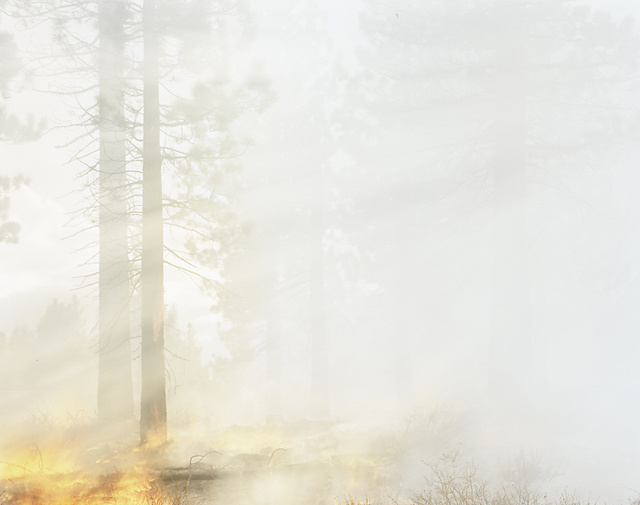Mossless in America is a column featuring interviews with documentary photographers. The series is produced in partnership with Mossless magazine, an experimental photography publication run by Romke Hoogwaerts and Grace Leigh. Romke started Mossless in 2009, as a blog in which he interviewed a different photographer every two days; since 2012 the magazine has produced two print issues, each dealing with a different type of photography. Mossless was featured prominently in the landmark 2012 exhibition Millennium Magazine at the Museum of Modern Art in New York; it is supported by Printed Matter, Inc. Its third issue, a major photographic volume on American documentary photography from the last ten years, titled The United States (2003–2013), will be published this spring.
Advertisement

Where there's smoke, there's California-based photographer Young Suh, who embeds himself with firefighters in the American West to make hazy pictures of controlled wildfires set by the US Forest Service. In his painterly photographs, Young renders the landscape simultaneously as an engineered space and as a wildly unpredictable natural force. Smoke obscures banal scenes and pristine vistas, and figures are dwarfed by the scope of Young's framing. We talked with him about the difficulty of photographing fires in places like Yosemite National Park, the use of American inmates as labor to help control these burns, and the lasting influence of the Hudson River School of painting.Mossless: How much time have you spent chasing wildfires with firefighters?Young Suh: I started making photographs of wildfires in 2008. For the first couple of years I didn’t really work with firefighters. I would be looking for information about wildfires from local newspapers and on the web and would drive to the area with very little sense of what it would be like. My trips would normally be three or four days at a time. I was originally drawn to vernacular landscapes near wildfires immersed in smoke without necessarily photographing an actual scene of fire. Many photographs from my Wildfires series are made at this time. Then, around 2010, I started contacting various fire departments in California, including Yosemite, in order to get access to their controlled-fire operations. Normally, controlled fires include many days of preparation prior to actual burning. Because each burn has to be cleared by a local Air Quality Control Commission and has to meet the optimal weather condition, I spent a lot of time waiting around the fire camp. One time I spent a week with firefighters for only an hour access to the burn site. In another place I could spend an entire day in the middle of a fire operation.
Advertisement
What is the process of making the pictures like?I travel with a handheld medium format camera and a 4x5 camera in a backpack. I walk around the site as much as possible, because fire and smoke are constantly shifting their forms. Once I decide to make a photograph, I quickly set up my 4x5 and make one or two exposures, then move my tripod 10 to 20 feet and take another shot, until I feel like I have what I want. Sometimes I shoot with my medium-format camera if I need to respond quickly. I constantly move around. The process is more like a slow version of street photography. It is as if the landscape constantly shifts its shape.Does the smoke cause any technical problems?It takes time to set up a large-format camera to make an exposure. Smoke itself doesn't really cause any mechanical problems, except that all my gear smells like a barbecued chicken.What did you make of the inmates working on the controlled fire operation?The photograph was taken during a controlled fire conducted in a prison land in Southern California. The land is normally used for training firefighters. When the prison inmates were brought out to help with the operation, it creates a scene where firefighters are managing two different kinds of threats to the society: one natural and the other human. We have mastered neither.The smoke from these wildfires bring these landscapes out of reality and into some kind of dreamscape. Do the scenes look as picturesque in person?
Advertisement
I am seduced by these scenes. Or, rather, I am seduced by the disappearance of them. The scenes are picturesque, but the disappearance of the landscape is sublime. I think the notion of the sublime implies blindness. It is an overwhelming sense of loss.Who are your favorite painters?I am thinking about two painters at the moment: Luc Tuymans and Sanford Robinson Gifford. Tuymans’s paintings stir up a sense of history in me. All of a sudden history doesn’t seem to have any order. There is no hierarchy in his subjects, whether coming from the past or the present. Tuymans magically puts them all to rest next to each other. Gifford made a series of studies of looking at the sunset through a gorge in the Catskill Mountains. The landscape disappears by the dazzling light from the sun, but the painting also anticipates the loss of light and the ultimate death of landscape.Young Suh is an assistant professor of photography at the University of California, Davis. He studied at the Pratt Institute in Brooklyn and the School of the Museum of Fine Arts in Boston. Follow Mossless on Twitter.